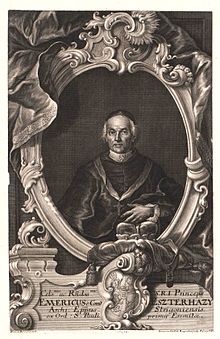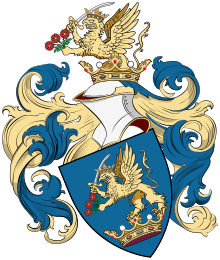Imre Esterházy de Galántha

Imre (Emmerich) II. Esterházy de Galántha (* around 1663; † December 6, 1745 in Pressburg ) was from 1725 to 1745 Metropolitan , Archbishop of Esztergom ( German Gran) and Prince Primate of Hungary .
Life
Imre (Emmerich) Esterházy came from the Hungarian nobility from the "Salamon" dynasty, whose documentary foundation appears in a document from the Archbishop's Archives of Esztergom. First, the young Imre studied in Rome and went there already as a gifted preacher , who in the papal chapel was allowed to preach on, later he joined the Order of the Paulaner at (OM), the general of the order , he was to become.
Esterházy was an extremely humble and godly man. He was a close confidante of Emperor Charles VI . as well as from Maria Theresia . He never used his numerous high-profile titles. He modestly signed his correspondence with "Frater Emericus".
In his homeland he gave theological and philosophical lectures and received archbishop support based on his family's monarchical ties with Vienna . His episcopal career began with the episcopal dignity in the diocese of Vác , from there he moved to Zagreb in 1709 . In Zagreb he defended the Emperor Charles VI. Established pragmatic sanction , which was of great importance for the elevation of his daughter Maria Theresa as heir to the imperial throne.
During this time, first the Croatian, then the Hungarian parliament passed the law on the female succession to the throne of the House of Habsburg. The succession plan was decided on March 11, 1712 by the Croatian Parliament ( Sabor ) and thus the right of inheritance of the female line of the Habsburgs within the Croatian national territory was recognized.
Other important reforms were also carried out, such as the establishment of the Hungarian Royal Lieutenancy Council ( consilium regium locumtenentiale Hungaricum ) and the district tables ( tabulae districtuales ), which initiated the modernization of the administration and the judiciary of the Kingdom of Hungary. Esterházy played a crucial role in both the preparation and implementation of these reforms. He thus became one of the most important personalities in corporate politics in the first decades of the 18th century.
In 1715 Imre Esterházy had received the count's diploma and from 1723 held the office of Bishop of Veszprém , this bishop's seat was considered the “springboard” to higher ordinations. He was also given the honorary title of Privy Councilor and the incumbent Primate of Hungary Christian August von Sachsen-Zeitz named him “Coadjutor cum jure successionis”. Thus he was appointed his successor in 1725 and, in addition to the archbishopric and the elevation to the primate of Hungary, also received the prince of the Holy Roman Empire of the German Nation . Therefore, in 1715, Emperor Charles VI. for the Archbishops of Gran the title of Prince Primate of Hungary ("Princeps Primas Hungariae"). Esterházy was the second holder of this title.
After Gran was occupied by the Turks in 1543 and came under the sovereignty of the Ottoman Empire , the seat of the archbishopric was moved to Tyrnau . However, the archbishops had their residences in nearby Pressburg, which at that time was also the capital of Hungary. Emmerich Esterházy also had his headquarters in the (old) Pressburg Primatialpalais and the Archbishop's Summer Palace at that time . The seat of the archbishopric was not moved back to Gran until 1820.
On June 25th, 1741 Maria Theresa was crowned Apostolic Queen of Hungary in St. Marinsdom in Pressburg. The St. Stephen's crown was her set by the then already very old "good Frater Emericus" (as Esterházy was affectionately called by the Queen) on his head.
Esterházy died on December 6, 1745 in Preßburg (from 1919 Bratislava) and was in St. Martin's Cathedral under the chapel of John the Almsgiver (also called Johannes Elemosynarius), which he had built on the church according to the plans of his famous court sculptor Georg Raphael Donner let, buried. The following Latin epitaph is written on the floor of the chapel:
SUB HOC ADMIRANDAE COMMISERATIONIS PRODIGIO DIVO IOHANNE ALEXANDRINO EGO IN TE DEUS MEUS MISERICORDIA MEA ASSISTANT MIHI DULCI MISERICORDIAE MATRE DORMIAM ET REGUIESCAM FRATER EMERICUS
(Here under the sign of the miraculous mercy of John of Alexandria , be in you my God, my mercy, and in trust in the intercession of our Blessed Mother I sleep and rest Brother Emericus )
A white marble relief of Donner adorns his tombstone.
Art patron
The Primate of Hungary spent over 2 million guilders for church and cultural purposes and was undoubtedly the most important church prince of the Esterházy family. For example, the baroque church in Esztergom was built with his financial help. Georg Raphael Donner, an Austrian sculptor, was appointed by him to Pressburg in 1729, where he built his own foundry for him. In the following years Donner cast several significant monuments here in Pressburg, Budapest and Vienna . The archbishop's influence on many of the artists who worked here was tremendously strong, and the sculpture of St. Martin and the chapel of St. John the Almsgiver in the cathedral, as well as some statuettes, testify to his great art. The following inscription is located above the entrance to the chapel:
NULLI SANCTORUM, SED IPSI DEO SANCTORUM, QUAMUIS IN MEMORIAM SANCTORUM CONSTITUIMUS ALTARIA. ("This altar was erected not for the saints, but for the God of saints, but only in memory of the saints.")
In 1735 he brought Donato Felice d'Allio to Pressburg to examine the sinking walls of the Capuchin crypt, and the church was rebuilt by 1737. D'Allio was employed as a builder and architect for various aristocrats , outside of Vienna this builder worked as a fortification engineer in Slavonski Brod (1726/7) and in Belgrade (1728).
Churches and parishes
In 1683 the archbishopric of Gran (Esztergom) was finally liberated from Ottoman rule, but the cathedral chapter remained in Tyrnau until the beginning of the 19th century , and the primates initially lived in their Bratislava palace. Several of them contributed significantly to the development of Pressburg, including Emmerich Esterházy, who had several churches built.
In 1742 the village of Pilisvörösvár near Budapest received a new landlord in the person of Johann Emmerich Graf Esterházy, the Archbishop of Gran. Johann Tersztyánszky von Nádas acquired the settlement, which was already predominantly inhabited by Germans, from him.
Individual evidence
- ↑ According to 'Koltai' different dates of birth are given in the literature: 9.8.1663, 5.11.1663, 17.12.1663, 17.12.1664, 20.7.1665 / 1666, 17.12.1665 and 27.7.1666. The date of birth on the sarcophagus is December 12, 1664. The place of birth is also not clearly established. But it is believed that Esterházy was born either in Neustadt an der Waag or at Beckó Castle . Quoted from: András Koltai: Császárhű, bőkezű, remete: Esterházy Imre hercegprímás. In: Limes. (Tatabánya: Kultsár István társadalomtudományi és kiadói alapítvány) XVIII (3), 2005, pp. 5-19, ISSN 0238-9266 . (Hungarian)
- ^ Genealogical handbook of the nobility - Princely houses.
- ^ EsterházyWiki about Zagreb
- ^ Anton Klipp: Pressburg. New views on an old city. Karpatendeutsches Kulturwerk, Karlsruhe 2010, ISBN 978-3-927020-15-3 , pp. 76-77.
- ↑ what is meant is John the almsgiver
- ↑ a b András Forgó: Esterházy Imre és az aulikus politika a 18. század elsö évtizedeiben (Hungarian; German: 'Emmerich Esterházy and courtly-minded politics in the first decades of the 18th century') p. 85.
- ↑ Short biography about Imre Esterházy
- ^ EsterházyWiki Esztergom
- ↑ Georg Raphael Donner on the country road. District Museum Landstrasse, archived from the original on December 5, 2013 ; accessed on January 3, 2018 .
- ↑ Quotation from the apologetic text Contra Faustum Manichaeum of St. Augustine (21st chapter)
- ^ Entry about Donato Felice D'Allio on Artisti Italiani in Austria , a project of the University of Innsbruck
- ↑ The Catholic Church Archives of Historical Hungary
- ↑ Information on Pilisvörösvár and Pilisszentiván. ( Memento from August 12, 2007 in the web archive archive.today )
Web links
| predecessor | Office | successor |
|---|---|---|
| Mihály Dwornikowich |
Bishop of Waitzen 1706 - 1708 |
Sigismund von Kollonitz |
| predecessor | Office | successor |
|---|---|---|
| Martin Brajković |
Bishop of Zagreb 1709 - 1723 |
Juraj Branjug |
| predecessor | Office | successor |
|---|---|---|
| Otto Chrystophorus Johannes de Volkra |
Bishop of Weissenbrunn 1723 - 1725 |
Péter Ádám Acsády |
| predecessor | Office | successor |
|---|---|---|
| Christian August of Saxony-Zeitz |
Archbishop of Gran 1725 - 1745 |
Miklós Csáky |
| personal data | |
|---|---|
| SURNAME | Esterházy de Galántha, Imre |
| ALTERNATIVE NAMES | Esterházy de Galántha, Imre II .; Esterházy, Emmerich |
| BRIEF DESCRIPTION | Metropolitan, Archbishop of Esztergom and Primate of Hungary |
| DATE OF BIRTH | around 1663 |
| DATE OF DEATH | December 6, 1745 |
| Place of death | Pressburg |





